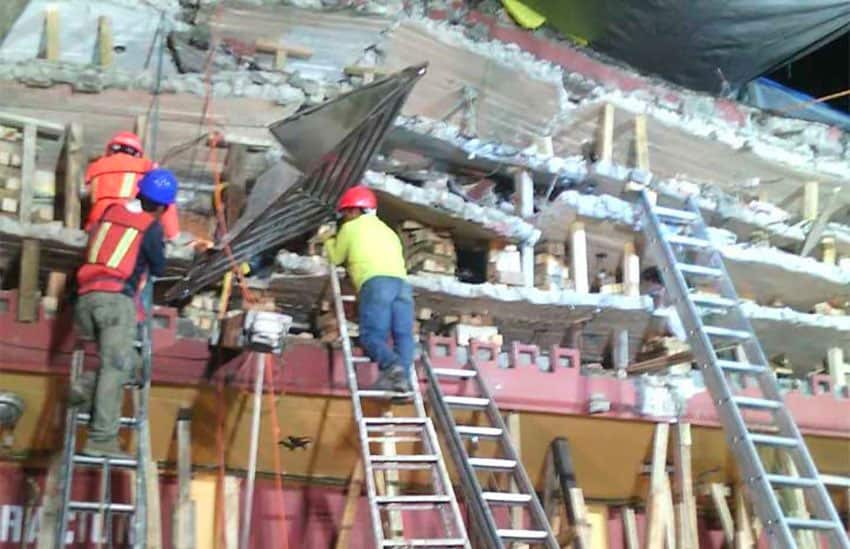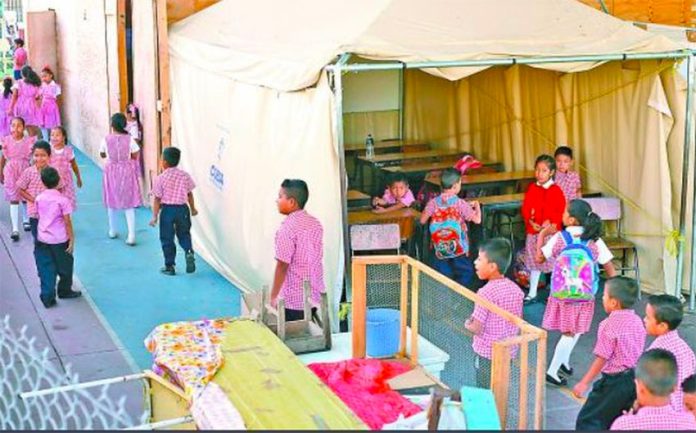Two years after two powerful earthquakes shook southern and central Mexico, repairs of damaged buildings are only 30% complete, the federal government has reported.
At Wednesday’s presidential press conference, Urban Development Secretary Román Meyer Falcón and national reconstruction coordinator David Cervantes provided an overview of the reconstruction progress that has been made since the earthquakes of September 7 and 19, 2017.
More than 186,000 homes, 19,198 schools, 297 hospitals and health care centers and 2,340 historical buildings in 700 municipalities were damaged in the two quakes, Meyer said.
Repairs of homes are 26% complete but by the end of the year that figure is expected to increase to 41%, Cervantes said. Guerrero and Morelos are leading the way in terms of the numbers of houses repaired or rebuilt.
Reconstruction of schools is 59% complete, while only 17% progress has been made on healthcare infrastructure, Cervantes said.
The Secretariat of Public Education said separately that repairs at schools in México state, Chiapas, Oaxaca, Puebla, Mexico City, Morelos, Tlaxcala, Michoacán, Guerrero, Hidalgo and Veracruz are ongoing. The Oaxaca Congress said earlier this month that only 80 of 5,000 schools that were damaged in the 8.2-magnitude earthquake on September 7 have been fully repaired.
Repairs of cultural and historical buildings are 47% complete, Cervantes said, explaining that the various figures equate to overall reconstruction progress of 30%.
Meyer and Cervantes said the National Reconstruction Program has prioritized repairs in areas that suffered the most extensive damage as well as those with high levels of violence and large indigenous populations.
In 2019, the federal government allocated 28.3 billion pesos (US $1.45 billion) for earthquake reconstruction, they said.
President López Obrador told reporters at yesterday’s press conference that his government won’t put a limit on the resources it will provide for earthquake rebuilding, adding that he expects repairs to be completed by the end of 2020 with the exception of some hospitals and churches that require major work.
He also said that construction companies who defrauded victims of their financial aid money must be held accountable in accordance with the law.

“Nobody is protected anymore, if fraud was committed . . . the developers must take responsibility . . .” López Obrador said.
Meyer pointed out that fraud wasn’t the only problem with the previous government’s earthquake aid program.
After the new government took office last December, it was discovered that a lot of families whose homes were damaged in one of the two September 2017 earthquakes didn’t receive the financial support they were promised, the secretary said.
“In states such as Chiapas, Morelos and Guerrero, the majority of affected families received incomplete support . . . In Chiapas, one in three families never received resources for reconstruction,” he said.
Cervantes said the government has handed out about 30,000 new stored-value cards to earthquake victims who didn’t receive the support they should have.
In the aftermath of the two devastating earthquakes, the previous federal government announced that people who lost their homes completely would receive financial support of 120,000 pesos (US $6,200 at today’s exchange rate) while owners of homes with repairable damage such as floor cracks or the partial collapse of a wall or roof would get 30,000 pesos.
In an interview with the newspaper El Economista, Cervantes said that unlike the previous government, the current administration is making sure that financial aid gets to the people who need it and is also following up to verify that the money is used for its intended purpose.
However – as the statistics on house repairs indicate – a lot of earthquake victims are still waiting for their homes to be fixed.
Karina Solís, a resident of the southern Mexico City borough of Tláhuac, told El Economista that her home sustained serious damage in the September 19 quake and that she and her family live in constant fear that it could collapse if another strong temblor were to occur.
Solís said that she and other affected residents of the capital who belong to the group United Victims of Mexico City are in a time-consuming and tiring battle with authorities to get them to repair and rebuild their homes and other damaged urban infrastructure.
“My life changed,” Solís said, explaining that if she’s not at work, she’s more often than not meeting with other earthquake victims to discuss what can be done to draw attention to their plight.
María Elena Vargas, a middle school Spanish teacher in the Mexico City borough of Iztapalapa, said that two years after the September 19 earthquake students of the Luis Pasteur 198 Secondary School are still taking classes in makeshift classrooms in the parking lot of a public park because repairs at the school haven’t been completed.
“They have been two years with a lot of difficulty. We’re not working in an optimal environment . . . If it’s difficult for the teachers, for the children it’s worse. When it’s hot the temperature in the prefabricated classrooms goes right up and apart from that they’ve been flooded,” she said.
Meanwhile, memorial services were held on Thursday to remember the victims of the 7.1-magnitude earthquake that rattled Mexico City and central states such as Puebla, Morelos and Tlaxcala.
One of the services was held outside the Unidad Multifamiliar Tlalpan, an apartment complex in southern Mexico City where several people were killed when one of the buildings collapsed. Almost 500 people were killed in the September 7 and 19 earthquakes and thousands more were injured.
In Mexico City and other parts of the country, citizens participated in a mass drill on Thursday in preparation for the next big earthquake. Thousands of buildings in the capital were evacuated during the drill, which is held annually on September 19 – the day that a huge earthquake devastated Mexico City in 1985.
Two years ago, the drill was held in the morning and just hours later, an earthquake struck. However, as a result of the epicenter’s proximity to Mexico City, buildings were already swaying – or falling – when the seismic alarm was activated.
Source: El Financiero (sp), El Economista (sp), Milenio (sp)
